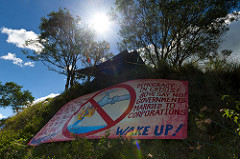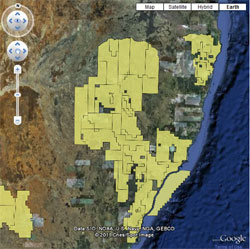By Bev Smiles, a spokeswoman for the Hunter Communities Network.
Originally published in the Newcastle Herald, 15 october 2012. Reproduced with the permission of the author.
THE approval of the Ashton South East open-cut mine on the southern side of Camberwell village is a prime example of the broken planning system in NSW.
Regardless of obvious long-term environmental and social impacts, the NSW government has demonstrated it will do everything in its power to get a coalmine approved. I believe the independence of the Planning Assessment Commission (PAC) can be viewed as severely compromised in this process.
The Ashton mine project is very small in the scheme of operations in the Upper Hunter. It plans to produce 12 million tonnes of coal over a seven-year period. Some of the larger mines produce that volume of coal every year.
So Ashton’s economic benefit and input to NSW treasury, through royalties, would be insignificant.
However, the environmental and social impact of the mine will be substantial over a very long period.
The Department of Planning made a recommendation in August 2011 that the mine be approved. That was contrary to the recommendation of two other government agencies, the Department of Health and the Office of Water, which did not support the project.
The Department of Health recognised that Camberwell village was already seriously affected by the dust and noise from three surrounding open-cut operations.
The cumulative impact of the Ashton South East open-cut will cause major health problems, not only for the people of Camberwell but for the Singleton district.
The Upper Hunter Air Quality Monitoring Network has sent out 16 health alerts in Camberwell from the end of August this year.
The daily average PM10 dust levels have exceeded the national health standards and the PM2.5 level has also been exceeded.
This is with the existing operations in the area. The cumulative impact of another open-cut mine will increase dust levels.
There is a recommendation that a dairy farm near the Ashton project be closed because of the predicted high dust levels.
The regulation of the coalmining industry in the Upper Hunter is not protecting the health of the community or the viability of food-production industries in the valley.
The NSW Office of Water objected to the project because of likely impacts on Glennies Creek.
This water source is regulated from Lake St Clair and provides water security to Lower Hunter water users, including the wine tourism industry at Pokolbin and Broke Fordwich. The water in the Hunter River above Glennies Creek is mostly extracted by Bayswater Power Station. Glennies Creek then becomes the major water source for all users downstream.
Ashton South East is a very deep pit that will dissect the groundwater system associated with the creek. It is only a few kilometres from the confluence with the Hunter River.
There is a risk of flows from the creek becoming connected to the mine through the braided gravel beds underlying the creek flats.
Contaminated water from the mine could affect the quality of the creek water with salt and heavy metals. The flood regime will be altered by high levee banks that have a risk of failing or over topping.
The impact of this mine on Glennies Creek and downstream water users could be major. The risk is too great for the minor economic benefit of extracting the coal.
In December 2011 the PAC rejected the project on the grounds outlined above. That decision was overturned on a technicality in the Land and Environment Court. The PAC was instructed to make a new determination.
In June 2012 the Office of Water changed its official position on the likely impacts of this mine, while acknowledging that a number of uncertainties and risks remained.
The commissioner’s final report indicated that baseline data is limited at present and that blasting and other mine operations could potentially affect measures taken to protect the creek.
The commissioner also reports that the change of position in the Office of Water is not based on any new information and there remains strongly divided opinion within the agency on the risks posed by the project.
The community can only assume that a great deal of political pressure has been exerted to get this mine approved. Advice from government technical experts on long-term impacts has been ignored.
There is an opportunity to appeal this decision in the Land and Environment Court. Community groups and affected residents of Camberwell are now considering their options.









